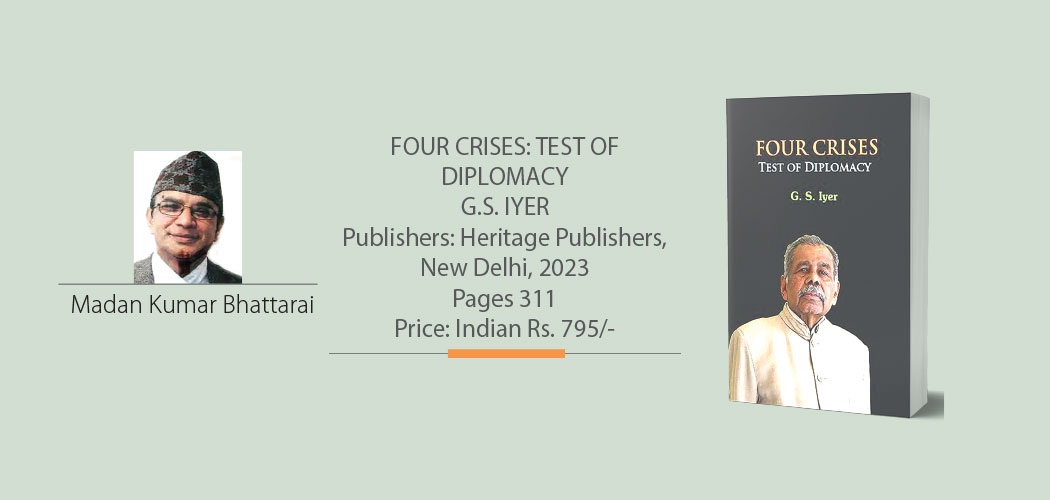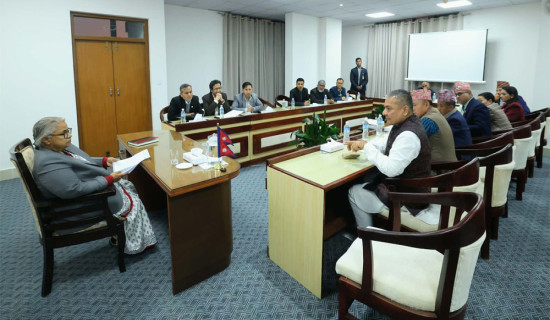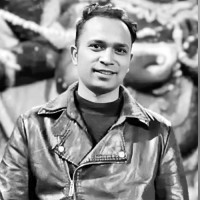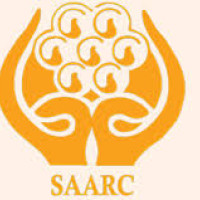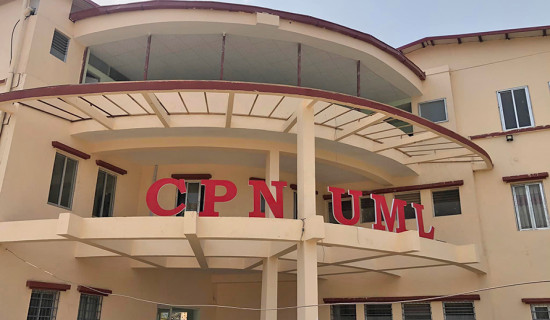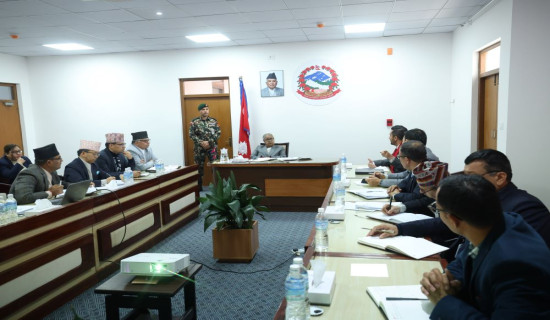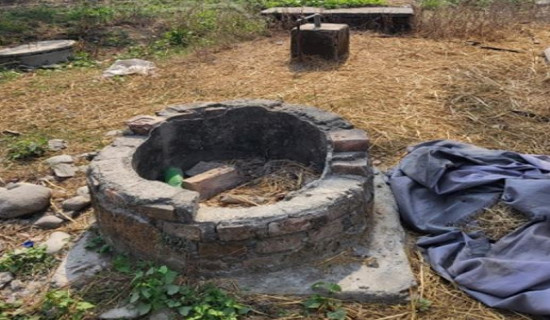- Tuesday, 9 December 2025
Diplomacy Through A Crisis Lens
Diplomats write memoirs to give meaningful perspectives of developments during service periods, commonly reported confidentially rather than made public. After superannuation, one of the favourite pastimes of most of the practitioners of the art and craft of diplomacy is to pen experiences in black and white.
Diplomatic literature is one of the most sought after exercises as readers know the details of international politics and also become conversant with matters that took place behind the scenes. At the same time, except in countries like Nepal, diplomatic accounts like other books by senior civil servants and politicians are in enormous demand, with commensurate pecuniary benefits for the writers.
G.S. Iyer, a career Indian diplomat belonging to 1965 batch of Indian Foreign Service (IFS), has followed such a familiar course but with a difference as his accounts are not comprehensive in the sense that they don't go to all aspects of his diplomatic life. He has decided to concentrate on four critical developments during his diplomatic postings. This is Iyer's second book after China Primer that he wrote some years back.
The book, FOUR CRISES: TEST OF DIPLOMACY, is divided into four parts, independently dealing with four countries, apart from a concise introduction. The first part encompasses Kibitzing a Revolution: Three Years in China that makes a perceptive study of the country during the Great Proletarian Cultural Revolution.
This was a topsy-turvy saga of upheavals China went through in the sixties and seventies, with Red Guards unleashed in reckless action supposedly under the direction of Chairman Mao Zedong, with the resultant disorder and purge of leaders. This part is divided into seven chapters and is 85 pages long. Iyer was then a junior diplomat with postings in Hong Kong and Beijing, as his CFL (compulsory foreign language) is Chinese, which he learnt in Hong Kong.
This was also the most challenging period of India-China relations, downgraded to Charge'd Affairs e.p. status after both countries withdrew their ambassadors from their respective capitals following 1962 border skirmishes, a situation only remedied in 1976 when they resumed ambassadorial relations.
The climax of bitter ties between the two biggest neighbours was the expulsion and physical abuse of two Indian diplomats in Beijing, which India reciprocated with the expulsion of two Chinese diplomats from the Indian capital. Understandably, Iyer thought it prudent to concentrate only on the mistreatment suffered by Indian diplomats and not on reprisal action, as he was both a witness and privy to developments in China.
The second part has a title, Copying with a Revolution: Experiences of Iran, again studied with a prismatic lens in seven different chapters with a total length of 46 pages. The climax of developments in 1979 included the decision of the Shah to permanently leave Iran and the American Embassy under siege for 444 days following the triumphal return of Ayatollah Khomeini from exile.
The third part, running 69 pages, pertains to Nepal and is of overwhelming interest to us and all those interested in Nepal-India ties. The author has dwelt all aspects of Nepal's political change in eight chapters under the composite heading, Copying with a Revolution: Reminiscences of Democracy Movement in Nepal (1989-1991). This portion lays bare India's overwhelmingly critical role taken as something smacking of highhandedness. It also exposes weaknesses and lack of clarity, and even double standards on the part of Nepali leadership.
This section gives a passing reference to Nepal's political and constitutional history along with the latest status of the country after the promulgation of the seventh constitution on September 20, 2015. The book also depicts the divergent standards of Indian Ambassador Lt. General S. K. Sinha and Foreign Secretary S. K. Singh when dealing with Nepal.
Three out of four countries that have become the book's focus are Asian, the last being a major country in Africa. This is more of a case study focusing on losing elections and winning a better job than a full-blown crisis, as applied in the earlier three cases. The focal point of this study is India's relations with Morocco, as the author served as Ambassador.
Shivshankar Menon, Foreign Secretary and National Security Adviser, taken as an amalgam of talent and pedigree in the IFS, has written the foreword. Calling the book a "sharp, insightful and honest" exercise between the two stools or extremes of objective accounts and the so-called inside story, Menon terms the first three crises involving China, Iran, and Nepal as events with "significant effects" on India. He classifies the fourth as "a crisis of our own making, or rather of our inexperienced leadership in 1984-5 in the bilateral relationship with Morocco".
On the debit side especially pertaining to Nepal, the author has used some photographs depicting interactions with Nepali leadership that came to power after 1990 political change as accessibility is probably the hallmark of our political class, irrespective of the actual status of foreign diplomats and external visitors.
This is best illustrated by the spontaneous presence of the first elected Prime Minister after the restoration of multiparty democracy at the farewell reception arranged by the Deputy Chief of Mission, despite the latter regretting during his courtesy call that protocol demanded that he could not invite him for the occasion.
Out of six photographs relating to Nepal, Iyer has made a mistake in at least one, using the photograph of Jog Mehar Shrestha with a caption showing Ganesh Man Singh, possibly as a consequence of apparent complacency coming out of too much of his familiarity with our political class.
While the coverage on Nepal has garnered significant space in the book, the back cover of the book dealing with the author's profile significantly fails to mention Nepal among stations of his posting possibly for two reasons, innocently sheer omission or simply realization often prevalent in India that Nepal is taken for granted and hardly matters in their scheme of things.
Despite such minor lacunae and hiccups, the book is essential to the literature on Indian diplomacy. Ambassador Iyer also served in Mexico as the top Indian diplomat apart from Morocco, and deserves thanks and appreciation for noble endeavours.
(Dr. Bhattarai is a former Foreign Secretary, Ambassador, and author, kutniti@gmail.com.)

